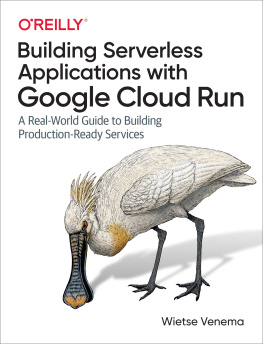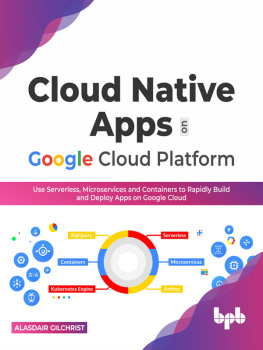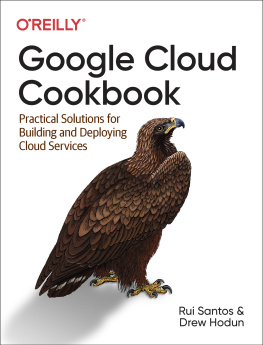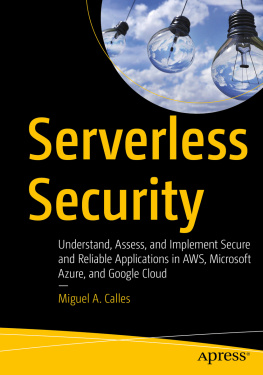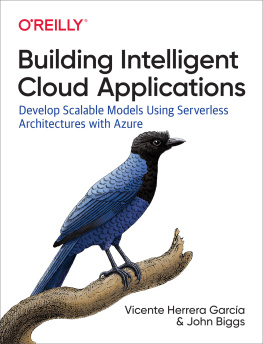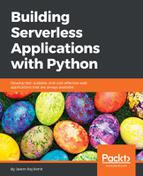Wietse Venema - Building Serverless Applications with Google Cloud Run
Here you can read online Wietse Venema - Building Serverless Applications with Google Cloud Run full text of the book (entire story) in english for free. Download pdf and epub, get meaning, cover and reviews about this ebook. year: 2020, publisher: OReilly Media, Inc., genre: Computer. Description of the work, (preface) as well as reviews are available. Best literature library LitArk.com created for fans of good reading and offers a wide selection of genres:
Romance novel
Science fiction
Adventure
Detective
Science
History
Home and family
Prose
Art
Politics
Computer
Non-fiction
Religion
Business
Children
Humor
Choose a favorite category and find really read worthwhile books. Enjoy immersion in the world of imagination, feel the emotions of the characters or learn something new for yourself, make an fascinating discovery.
- Book:Building Serverless Applications with Google Cloud Run
- Author:
- Publisher:OReilly Media, Inc.
- Genre:
- Year:2020
- Rating:5 / 5
- Favourites:Add to favourites
- Your mark:
- 100
- 1
- 2
- 3
- 4
- 5
Building Serverless Applications with Google Cloud Run: summary, description and annotation
We offer to read an annotation, description, summary or preface (depends on what the author of the book "Building Serverless Applications with Google Cloud Run" wrote himself). If you haven't found the necessary information about the book — write in the comments, we will try to find it.
Building Serverless Applications with Google Cloud Run — read online for free the complete book (whole text) full work
Below is the text of the book, divided by pages. System saving the place of the last page read, allows you to conveniently read the book "Building Serverless Applications with Google Cloud Run" online for free, without having to search again every time where you left off. Put a bookmark, and you can go to the page where you finished reading at any time.
Font size:
Interval:
Bookmark:

Wietse Venemas book goes into significant technical depth while also keeping the reader grounded with realistic scenarios. I had the opportunity to review it, and look forward to purchasing a copy of my own so that I can read it again. Google Cloud Run may be the most interesting compute platform youll use in the years ahead, and this book will help you build up the knowledge you need to successfully use it.
Richard Seroter, Director of Outbound Product Management at Google Cloud
Get ready for what I believe is going to be the de facto reference book for Google Cloud Run. Wietse Venema explores and explains every facet of the product and goes into details of building production-grade serverless apps. As a Cloud Run Product Manager, I helped review every chapter for accuracy.
Steren Giannini, Cloud Run Product Manager at Google Cloud
This is the most comprehensive, yet approachable guide to getting started with Cloud Run (and its vast array of accompanying tools and technologies) that currently existsno small feat for a technology thats seen rapid evolution over the past 12 months. From introducing the concept of containers, to discussing the real-world considerations when deploying Cloud Run as part of a microservices-based architecture, Wietse has written a book that will appeal to both newcomers to Google Cloud and veteran developers alike .
Chris Tippett,
Principal Consultant at Servian (UK)
What can I say...this guy definitely knows what hes talking about. He is as enthusiastic about the subject as most people are about little puppies, and manages to explain it in a way that anyone can understand it. His diagrams are a strong part of the book. They help you understand topics that can be daunting and difficult to comprehend, especially for junior backend developers like myself. Go buy this book, it will make your life running in the cloud a whole lot easier!
Femke Buijs,
Software Engineer at Mollie
Developers looking to future proof their career for the next decade will love this book because: #1 It is a practical, easy to read and concise guide on Cloud Run (the technology that finally closes the gap between Serverless and Containers). #2 The author covers a broad set of managed services on Google Cloud Platform to help you become productive quickly (even if youre new to GCP). #3 If youre skeptical about vendor lock-in, you will appreciate the section on how to take your serverless containers and move out of the Google Cloud.
Daniel Zivkovic, Solution Architect and Organizer of Serverless Toronto User Group
Wietse has an engaging and personal style that makes this book a pleasure to read. What I like especially, is that apart from essential knowledge about Cloud Run, it also contains plenty of anecdotes, best practices, and useful advice to make you a better application developer. Highly recommended!
Robbert Brak,
Principal Software Engineer at 4me
by Wietse Venema
Copyright 2021 Wietse Venema. All rights reserved.
Printed in the United States of America.
Published by OReilly Media, Inc., 1005 Gravenstein Highway North, Sebastopol, CA 95472.
OReilly books may be purchased for educational, business, or sales promotional use. Online editions are also available for most titles (http://oreilly.com). For more information, contact our corporate/institutional sales department: 800-998-9938 or corporate@oreilly.com .
- Acquisitions Editor: Jennifer Pollock
- Developmental Editor: Sarah Grey
- Production Editor: Beth Kelly
- Copyeditor: Holly Bauer Forsyth
- Proofreader: Rachel Monaghan
- Indexer: Sue Klefstad
- Interior Designer: David Futato
- Cover Designer: Karen Montgomery
- Illustrator: Wietse Venema
- December 2020: First Edition
- 2020-12-02: First Release
See http://oreilly.com/catalog/errata.csp?isbn=9781492057093 for release details.
The OReilly logo is a registered trademark of OReilly Media, Inc. Building Serverless Applications with Google Cloud Run, the cover image, and related trade dress are trademarks of OReilly Media, Inc.
The views expressed in this work are those of the author, and do not represent the publishers views. While the publisher and the author have used good faith efforts to ensure that the information and instructions contained in this work are accurate, the publisher and the author disclaim all responsibility for errors or omissions, including without limitation responsibility for damages resulting from the use of or reliance on this work. Use of the information and instructions contained in this work is at your own risk. If any code samples or other technology this work contains or describes is subject to open source licenses or the intellectual property rights of others, it is your responsibility to ensure that your use thereof complies with such licenses and/or rights.
978-1-492-05709-3
[LSI]
I started my career as the dot-com bubble was inflating. Companies set their sights on becoming the future of [fill in the blank] by leveraging the internet to transform how people did everything from ordering pet food to buying books. Companies rushed to build data centers, filled them with servers, and began writing the software that would go on to eat the world, but not before the bubble burstmost companies filed for bankruptcy but left the servers and a mountain of technical debt behind.
The bursting of the dot-com bubble gave birth to a universe where every company was transformed into a tech company built on top of server farms and the weeds of infrastructure that grew around them. Soon the technical debt caught up to us and forced the industry to slow downway downand shift focus to keeping the lights on. Instead of building innovative applications for our customers, most of us spent our time patching servers and hiding behind firewalls, while our security teams chased vulnerabilities around.
What was supposed to propel us into the future became an anchor to the past.
While our server farms were slow to evolve, the cloud came to the rescue and offered a faster, cheaper, and better alternative. Instead of racking and stacking our own servers, we could rent theirs by the hour. While this was indeed an improvement, there was still something holding us backservers.
Automation tools came and went, each offering a better way of managing servers but still occupying too much of our time. In parallel, the application side of the industry was evolving much fasterand developers decided to take things into their own hands. They created containers, which introduced a universal way of packaging applications that no longer required servers to be configured correctly before applications could run on them.
Platforms like Docker and Kubernetes enabled the industry (particularly sysadmins) to run containerized applications across our existing servers, and eventually shed light on a set of cloud native patterns for doing so at scale. Kubernetes is considered a wildly successful project, but even it falls short of eliminating the challenges of running the servers underneath, which still need to be patched, configured, and maintained.
What you are holding in your hands is a peek into a serverless future, where the concept of a server has been buried under a set of cloud native abstractions and workflows dedicated to running and securing your containerized applications. This is a future where cloud providers bear the burden of managing servers, so you can focus on building innovative applications for your customers.
Font size:
Interval:
Bookmark:
Similar books «Building Serverless Applications with Google Cloud Run»
Look at similar books to Building Serverless Applications with Google Cloud Run. We have selected literature similar in name and meaning in the hope of providing readers with more options to find new, interesting, not yet read works.
Discussion, reviews of the book Building Serverless Applications with Google Cloud Run and just readers' own opinions. Leave your comments, write what you think about the work, its meaning or the main characters. Specify what exactly you liked and what you didn't like, and why you think so.

